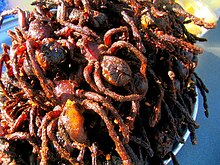Some arachnids may be used for human consumption (edible arachnids), either whole or as an ingredient in processed food products such as cheese (Milbenkäse).[1] Arachnids include spiders, scorpions, and mites (including ticks).

Spiders
editAbout 15 species of spiders are scientifically described as being edible, with a history of human consumption.[2] These edible spiders include:
- Thailand zebra leg tarantula (Cyriopagopus albostriatus) which is sold fried as traditional snack in Cambodia and Thailand;
- Thailand Black (Cyriopagopus minax);
- Goliath birdeater (Theraphosa blondi);
- several other species of tarantula;
- the golden orb-weaving spider (Trichonephila edulis) that is eaten in New Caledonia and is said to taste like pâté.[3]
Scorpions
editFried scorpion is traditionally eaten in Shandong, China.[4]
Mites
editMilbenkäse (mite cheese) is a German speciality cheese.
Mimolette is a mite cheese traditionally produced around the city of Lille, France.
Cheese mites could cause an allergic reaction if consumed in large quantities (above the standard of six mites per cubic inch).[5]
Processing
editTypical processing of arachnids as food includes heating, defanging and, in certain cases, drying and grinding.[1]
Footnotes
edit- ^ a b Costa-Neto, E.M.; Grabowski, N.T. (27 November 2020). "Edible arachnids and myriapods worldwide – updated list, nutritional profile and food hygiene implications". Journal of Insects as Food and Feed. 7 (3): 261–280. doi:10.3920/JIFF2020.0046. ISSN 2352-4588.
- ^ Yde Jongema (1. April 2017): List of edible insects of the world. Wageningen University.
- ^ Low, Tim (8 August 2016). "The tasty spider". Australian Geographic. Archived from the original on 26 October 2020. Retrieved 19 March 2021.
The scientific name of this spider celebrates its culinary merits. French naturalist Jacques Labillardiere bestowed the name in 1799 after seeing the spiders roasted and eaten in New Caledonia.
- ^ Forney, Matthew (11 June 2008). "Scorpions for Breakfast and Snails for Dinner". The New York Times.
- ^ Fletcher, Janet (25 October 2013). "Mimolette imports on hold". SFGate. Archived from the original on 6 March 2014. Retrieved 19 March 2021.
[...] the Food and Drug Administration began holding shipments of Mimolette because of tiny mites on the rind. They deemed the mites an allergen and health hazard [...]